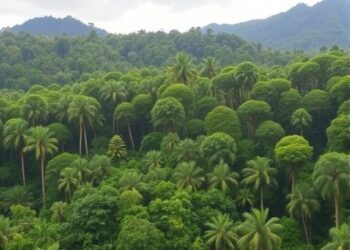Airborne observations over California have revealed that biogenic sources of volatile organic compounds (VOCs) – blooming trees and growing plants – dominate summertime air pollutant formation in Los Angeles, in a way that increases with temperature. Future air pollution regulations thus need to consider that only 40% of urban VOC emissions (those not tied to biogenic sources) can be mitigated through regulations, say the authors. Ambient air pollution – the fourth-leading global health risk – causes an estimated 4.2 million premature deaths annually. Key pollutants include fine particulate matter (PM2.5) and tropospheric ozone, both of which are formed from VOC precursors. Despite advancements in reducing automotive VOC emissions, concentrations of ozone and PM2.5 have stagnated since 2010, partly due to the rising contribution of VOCs from other sources: chemical products and plants. This has challenged existing models on the sources of secondary organic aerosols (SOA). In Los Angeles, the origin of SOA is under debate, with some studies reporting a predominantly vehicular source. Other studies indicate that high temperatures significantly increase PM2.5 and ozone levels, suggesting a bigger role for biogenic emissions. With climate change expected to increase the number of hot days, it is crucial to understand how temperature affects VOC emissions and secondary air pollutant formation. This will help inform effective regulation strategies.
Airborne observations over California have revealed that biogenic sources of volatile organic compounds (VOCs) – blooming trees and growing plants – dominate summertime air pollutant formation in Los Angeles, in a way that increases with temperature. Future air pollution regulations thus need to consider that only 40% of urban VOC emissions (those not tied to biogenic sources) can be mitigated through regulations, say the authors. Ambient air pollution – the fourth-leading global health risk – causes an estimated 4.2 million premature deaths annually. Key pollutants include fine particulate matter (PM2.5) and tropospheric ozone, both of which are formed from VOC precursors. Despite advancements in reducing automotive VOC emissions, concentrations of ozone and PM2.5 have stagnated since 2010, partly due to the rising contribution of VOCs from other sources: chemical products and plants. This has challenged existing models on the sources of secondary organic aerosols (SOA). In Los Angeles, the origin of SOA is under debate, with some studies reporting a predominantly vehicular source. Other studies indicate that high temperatures significantly increase PM2.5 and ozone levels, suggesting a bigger role for biogenic emissions. With climate change expected to increase the number of hot days, it is crucial to understand how temperature affects VOC emissions and secondary air pollutant formation. This will help inform effective regulation strategies.
Previous efforts to understand the magnitude and composition of VOC emissions in major urban centers, including Los Angeles, have relied on indirect methods subject to large uncertainties. To overcome this, Eva Pfannerstill and colleagues conducted airborne flux measurements to directly map VOC emissions above Los Angeles and over a range of temperatures (15ºC to 37ºC). Using proton transfer reaction (PTR)-time-of-flight mass spectrometry, Pfannerstill et al. identified more than 400 VOC species from a wide range of biogenic and anthropogenic sources. The authors found that temperature-dependent emissions are driving ozone and secondary organic aerosol pollution in Los Angeles, with roughly 60% of both pollutants formed through reactions associated with biogenic VOC emissions from blooming plants or from plants experiencing heat or drought stress. Moreover, Phannerstill et al. show that some anthropogenic VOC emissions strongly increase with temperature, which is an effect not currently represented in current emission inventories. The findings highlight that climate change could increase urban air pollution events unless anthropogenic emissions are significantly reduced. Reducing anthropogenic VOC emissions on high-temperature days is crucial, as biogenic emissions increase during flowering and drought stress and cannot be regulated. “The mapping of VOC emissions from airborne platforms, as performed by Pfannerstill et al., opens a new frontier for the improvement and verification of spatially resolved emission maps, which form the backbone of any meaningful air quality prediction model system,” writes Thomas Karl in a related Perspective.
Journal
Science
Article Title
Temperature-dependent emissions dominate aerosol and ozone formation in Los Angeles
Article Publication Date
21-Jun-2024




